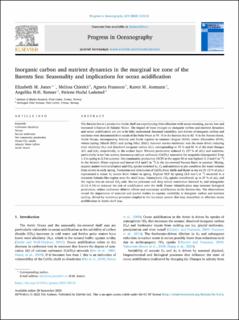| dc.description.abstract | The Barents Sea is a productive Arctic shelf sea experiencing Atlantification with ocean warming, sea ice loss and increased influence of Atlantic Water. The impact of these changes on inorganic carbon and nutrient dynamics and ocean acidification are yet to be fully understood. Seasonal variability and drivers of inorganic carbon and nutrients were determined from south of the Polar Front at 76 °N in the Barents Sea to 82 °N in the Nansen Basin, Arctic Ocean, encompassing Atlantic and Arctic regimes in summer (August 2019), winter (December 2019), winter/spring (March 2021) and spring (May 2021). Summer sea-ice meltwater was the main driver reducing total alkalinity (AT) and dissolved inorganic carbon (CT), corresponding to 55 % and 81 % of the total changes ΔCT and ΔAT, respectively, in the surface layer. Primary production reduced CT (37 % of ΔCT) and nutrients, particularly in ice-free waters, increasing calcium carbonate (CaCO3) saturation for aragonite (Ωaragonite) from 1.3 in spring to 2.3 in summer. Net community production (NCP) in the upper 50 m was highest (1.3 mol C m−2) in the Atlantic Water regimes and lowest (0.4 mol C m−2) in the ice-covered Nansen Basin in summer. Mixing, organic matter remineralisation and CO2 uptake enriched AT, CT and nutrients to pre-condition the water column from winter to early spring. Formation and dissolution of CaCO3 from shells and ikaite in sea ice (5–13 % of ΔAT) represented a minor AT source from winter to spring. Highest NCP by spring (0.3 mol C m−2) occurred in a transient Atlantic-like regime over the shelf slope. Atmospheric CO2 uptake contributed up to 37 % of ΔCT and the region was an annual CO2 sink. Sea-ice processes and deep winter convection lowered AT and Ωaragonite (1.12–1.14) to enhance the risk of acidification over the shelf. Future Atlantification may increase biological production, reduce meltwater dilution effects and counteract acidification in the Barents Sea. The observations reveal the importance of seasonal and spatial studies to capture variability in inorganic carbon and nutrient cycling, driven by numerous processes coupled to the ice-ocean system that may exacerbate or alleviate ocean acidification in Arctic shelf seas. | |
